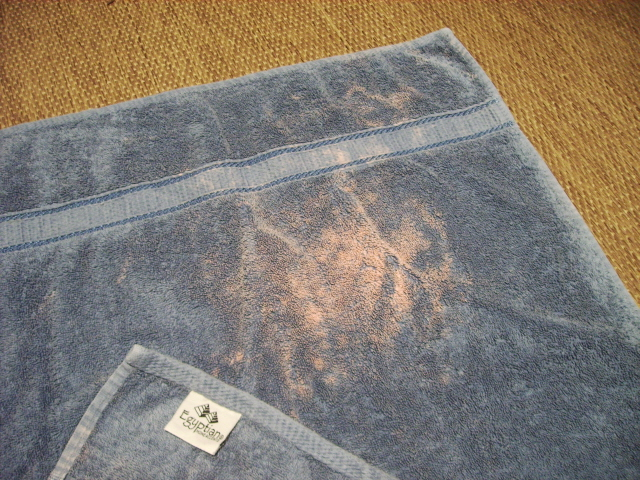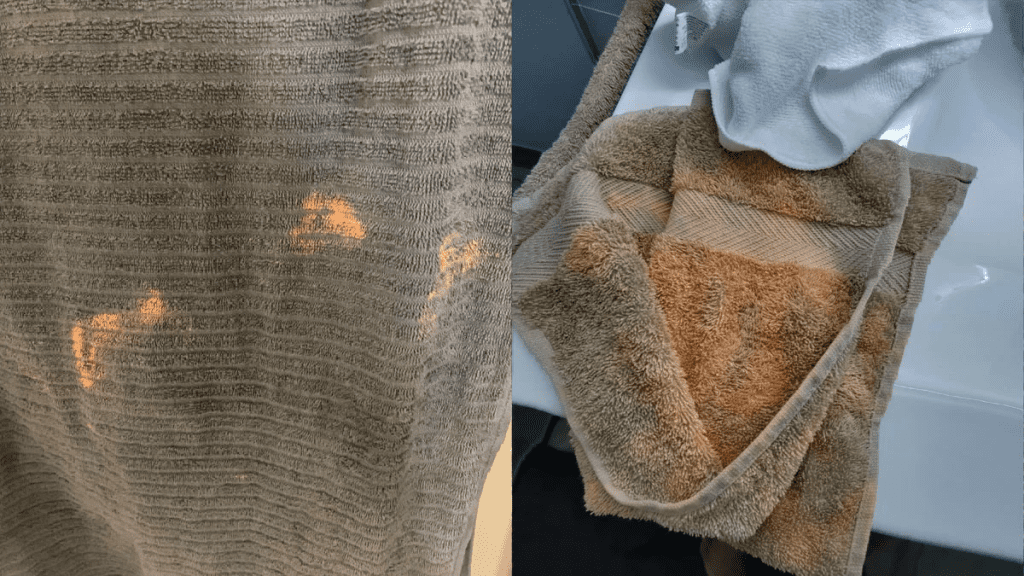The First Encounter with the Stubborn Stain
I’ll never forget the first time it happened—a glaring, almost neon-orange blotch appeared right in the middle of my favorite gray towel. It didn’t look like a coffee spill or makeup smudge. It had this strange bleached-out glow, like someone had swiped a highlighter across the fabric. Naturally, I assumed it was nothing a good wash couldn’t fix. I tossed it in the laundry with extra detergent, confident it would come out spotless. But when it emerged from the dryer, the stain was still there… unchanged.

Within weeks, a few more towels fell victim to the same fate. My once-pristine bathroom linens looked like they’d been attacked by a pumpkin-loving ghost. If you’ve noticed these stubborn orange marks on towels, pillowcases, or even T-shirts, you’re not imagining things—and the cause is far more common than you might think.
The Hidden Culprit in Your Skincare Routine
One of the most notorious offenders is benzoyl peroxide, the acne-fighting ingredient in many face washes and spot treatments. While it’s great for keeping your skin clear, it’s ruthless on fabrics. Benzoyl peroxide acts like a bleaching agent, stripping dye right out of the fibers. That’s why the marks aren’t “stains” in the traditional sense—they’re actually bleach spots, often appearing as orange or yellowish patches on darker fabrics.
Video : Why Do I Have Rust Stains on My Clothes After I Wash Them? | Angel Water, Inc
And here’s the frustrating part: because the dye is chemically removed, no amount of scrubbing, soaking, or stain remover will bring the original color back. I learned this when I realized my nightly routine—patting my face dry with a towel after applying acne cream—was slowly destroying my linen collection.
Rust and Iron: The Water Problem You Can’t Ignore
If skincare products aren’t to blame, your water supply might be. Areas with high iron content—especially homes that use well water—are prone to rust stains. These appear as small, scattered orange freckles across fabric. Standard laundry detergent won’t touch them; instead, you need a specialized rust-removing additive to break down or bind the iron before it bonds to your towels.
I discovered this firsthand while visiting a friend’s rural home. After just two washes in her water, my white towel looked like it had spent a week under a rusty garden tap.

The Sneaky Stains from Hair Care and Self-Tanners
Your shampoo and conditioner might be part of the problem, too—especially if they contain color-depositing pigments or “warmth-enhancing” tones. Self-tanning products are another major offender. Even if your skin feels dry, the pigment can transfer when you towel off, leaving behind streaks or patches.
This happened to me with a “color-enhancing” shampoo that subtly deposited pigment. My hair towels started showing faint orange marks until I connected the dots.
Cleaning Products That Double as Fabric Bleach
Certain household cleaners—like toilet bowl scrubs, disinfectant sprays, and even some multi-surface wipes—contain bleach or hydrogen peroxide. If you use these and then dry your hands on a nearby towel, you could unknowingly cause permanent discoloration.
A friend once turned her kitchen towels pink during a deep clean, only to realize her counter spray was the real culprit.
Video : How to Get Rid of Orange Spots On Towels
How to Prevent the Infamous Orange Patch
Once you know the triggers, prevention becomes much easier:
- Use white towels or washcloths for skincare routines that involve benzoyl peroxide.
- Wait for self-tanners and hair products to fully dry before touching fabric.
- Assign old towels for hair care to avoid pigment transfer.
- If you have iron-rich water, use a rust-removal laundry additive regularly.
- Keep cleaning chemicals away from fabrics you want to keep stain-free.
The Harsh Truth About Removal
If benzoyl peroxide or bleach caused the mark, the damage is permanent. Your only real options are to repurpose the towel, dye it a darker color, or bleach the entire fabric for a uniform look. Rust or mineral stains, however, can sometimes be removed with fabric-safe rust removers.

The key is learning to identify the type of discoloration:
- Bleach damage: Larger, irregular patches in areas where your skin or hands often touch.
- Mineral stains: Small, speckled marks scattered across the fabric.
Final Thoughts
These orange patches might seem like random fabric curses, but they almost always have a logical—and preventable—cause. Whether it’s your skincare routine, your water supply, your hair products, or your cleaning habits, identifying the source can save you from ruining towel after towel. I’ve gone from losing multiple towels each season to maybe one every year. And trust me—once you spot the pattern, keeping your linens fresh and flawless feels a lot less like guesswork and a lot more like victory.